|
Summary: An interplanetary shock
wave (generated by a coronal mass ejection from the
giant sunspot 9393) passed NASA's ACE spacecraft at 0030 UT on March
31st (7:30 pm EST on March 30th) and struck Earth's magnetosphere about 30 minutes later.
The leading edge of the
shock front
was dense (~150 protons/cc) and strongly magnetized -- traits
that can (and did!) give rise to powerful geomagnetic disturbances.
Sky watchers spotted Northern Lights as far south as Mexico.
Unless
otherwise stated, all images are copyrighted by the photographers.
|
|
Photographer, Location |
Images |
Comments |
 |
LeRoy Zimmerman,
Fairbanks, Alaska |
#1,
#2, #3,
more |
These stunning panoramas by LeRoy Zimmerman are
a must-see! March 31, 2001 (1940 PDT) |
 |
Dennis
Mammana, San Diego, CA |
#1,
more |
D. Mammana captured this image of red auroras
and cirrus clouds near the Sunrise Highway east of
San Diego. Photo details: Fuji Superia (ISO 800), Nikon F camera,
35mm Nikkor f/1.4 lens, 60 seconds at f/2. March 31, 2001
(1940 PDT) |
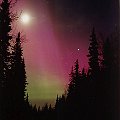 |
Jan Curtis,
Fairbanks, Alaska |
#1,
#2, #3,
#4, more |
Veteran aurora photographer J. Curtis captured
#1, #2
and #3 on March 30th
(10:30 pm local time) and #4
on March 31st (11:50 pm). Photo details: Film Supra 800, 35 mm
lens @ f/2.0, exposures (#1, 15 secs), #2, 5 secs, #3 20 secs,
#4, 15 secs. |
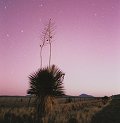 |
Chris
Grohusko, Cornudas Mountains, west Texas |
#1,
#2, #3 |
C. Grohusko captured these pictures in a place
where auroras are rare indeed -- west Texas. The thumbnail shows
Texan Northen Lights at dawn. Photo details: 20 seconds exposure,
28mm f/2.8, Fuji 800 Superia film. March 31, 2001 (2220 PST) |
 |
Dawn Schur,
Payson, Arizona |
#1, more |
D. Schur: "We have seen some auroras here
before, but only the red ones. This one was so much more. There
were red curtains and green streamers that were pulsating all
across the sky. " March 31, 2001 |
 |
Chris
Petrich, Dunedin, New Zealand |
#1,
#2, #3 |
Chris Petrich: "Auroras filled the sky from
midnight until 2am. I took these photos well within city limits."
Photo details: #1 15sec, #2 and #3 30s, 28mm Nikkor, 2.8, Kodak
Gold 100. April 1, 2001 |
 |
Ron Giachetti,
Spokane, WA |
#1,
#2, #3 |
Ron Giachetti: "Last night was ablaze in
colors here in Spokane. The sky was reddish by 8 P.M. PST. I
drove north about 30 miles to take these pictures... between
11 P.M. and 12:30 A.M. PST." Photo details: digital Toshiba
PDR-M70 with exposure times from 15 to 60 seconds. March 30-31,
2001 |
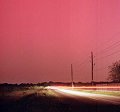 |
Mark Egan,
Houston, Texas |
#1, #2 |
Mark Egan spotted this red glow over Houston
as the auroral storm spread to southern latitudes. Photo details:
Pentax K-1000; Kodak Portra 160 NC print film; exposures 5 to
20 sec. March 31, 2001 |
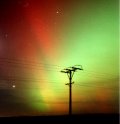 |
Forrest
E. Ray, Twin Falls, Idaho |
#1, #2 |
F. Ray: "The sky was over 95% filled with
aurora. We have never experienced such a show at this lattitude!"
Photo details: Spotmatic Pentax Camera 400 speed Fuji film, 16
s exposures. March 30, 2001 (11 pm MST) |
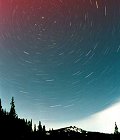 |
Jimmy
Westlake, Steamboat Springs, CO |
#1 |
J. Westlake captured this image of startrails
and auroras through the clouds over Colorado. Photo details:
30 minute exposure, 35 mm lens at f5.6, Kodak Max 400 film March
31, 2001 (9:08-9:38 PM MST) |
 |
Dave Curtis,
Dunedin, New Zealand |
#1,
#2, #3,
#4, #5,
#6, #7 |
D. Curtis: "These were taken from my home
in Dunedin using a Canon F1 with a 24-48 Tamron zoom. Film was
Fujicolor Superia 400ASA." March 31, 2001 |
 |
Ulrich
Rieth, Mainz, Germany |
#1, #2, #3 |
U Rieth: "The camera was a Canon FT with
28mm f/2.8 lens. The film is Fuji Sensia 400 color slide film.
Exposure times were between 30 and 60 seconds." March
31, 2001 |
 |
Michel
Benvenuto, Nice, France |
#1,
#2, #3 |
On a spring Saturday night just a few miles from
the beaches of Nice, France, Michel Benvenuto captured these
images using a 17mm lens at F/D 3.5 in
40s on Fujicolor Press 800. April 1, 2001 |
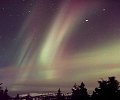 |
Ulrike Haug,
near Fairbanks, Alaska |
#1, #2, #3,
#4, #5,
#6, #7 |
U. Haug: "I took those images with a Minolta
35 mm camera, 24 mm f2.8 and 35 mm f1.8 lenses exposed with f2.8
and between 10 to 20 seconds on Kodak Max 800 ISO. In the soft
corona (#5) you can see
the Big Dipper." March 30-31,
2001 |
 |
Jessica
and Brian Williams, Kalispell, Montana |
#1,
#2, #3,
#4, #5 |
J. Williams: "[It] began with opal-colored
rays in the northwest, then the south sky turned red and a sort
of epicenter appeared at zenith - rays were beaming from it in
all directions. We used 800 speed film in our 35 mm Minolta X700
on a tripod. F1.7 with auto-exposure" March
31, 2001 (0530 - 0700 UT) |
 |
Mike Blackburn,
Boise, Idaho |
#1,
#2 |
M. Blackburn: "At one point we had aurora
visible for 360 degrees. The intensity was simply staggering."
Photo details: 35 mm 400ASA film with 21 mm f3.5. Exposure 40
seconds." March 31, 2001 |
 |
Pete Strasser,
near Sacramento, CA |
#1,
#2 |
Pete Strasser: "The early-evening sky had
a nice glow, then at 11:00 pm PST, it burst into color, moving
fast with bands shimmering well past the zenith. It lasted like
this for about 40 minutes." Photo details: Zeiss Ikon Contaflex
Super B and a Pro-Tessar 35mm Wide angle lens, using Fuji Superia
800 film 15 second exposure March 30, 2001 (PST) |
 |
Brian Klimowski,
Rapid City, Sorth Dakota |
#1,
more |
B. Klimowski: "It was a gorgeous display,
extending from horizon to horizon and overhead. Spectacular!
March 30, 2001 (11:30 pm MST) |
 |
Ronnie
Sherrill, Troutman N.C. |
#1,
#2, #3,
#4 |
Photo details: Olympus OM1 camera, Kodak Max
400 film ,(#1 &
#2) 28mm f 3.5 , 40
sec. exp; (#3 &
#4) hubcap, 135mm
f 3.5 , 1 min. exp. March 31, 2001 (06-0700 UT) |
 |
Tom Warner,
Rapid City, SD |
#1,
#2, more |
Photo details: Nikon FM2 20 mm lens, f2.8, 1
min exposure, Fuji Provia 100F (ISO 100). March 31, 2001 (0415
UT) |
 |
Elizabeth
Passuello, Greymouth, New Zealand |
#1,
#2, #3 |
Photo details: 1 minute exposures, Nikkor 24mm
lens and Fujicolor Press 800 print film. March 31, 2001 |
 |
Mark Simpson,
Alberta, Canada |
#1,
#2, #3,
#4, #5 |
These five pictures include Canmore, Banff, and
Sibbald Creek in Alberta, Canada. For more information click
here. March 30-31, 2001 |
 |
David
Copley, Grand Junction, Colorado |
#1 |
Photo details: 28 mm lens at f2.8 on Fuji 800
print film, 20 second exposure. March 30, 2001 (11:15 pm MST). |
|
[image] |
Robert
and Adam Smith, Stoneville, NC |
#1, #2, #3 |
Photo details: Camera Fuji ST605N. Yashinon 55mm
lens 1.2 with Spiratone Curvatar wide-angle attachment. Fuji
200 Super HQ film. March 31, 2001 (11:30 pm EST). |
|
[image] |
UCLA Solar
Towercam, Mt. Wilson, California |
#1,#2 |
An automated camera on Mt. Wilson in southern
California catured these images of rare red aurora. The dome
in the foreground houses the famous Mt. Wilson 100-inch telescope.
March 30, 2001 (2220 PST) |
|
[image] |
Mark Cunningham,
Craig, CO |
#1,
#2 |
Mark Cunningham captured these images during
a 3 hour aurora storm over his backyard observatory in Colorado.
March 31, 2001 |
|
[image] |
Jan
Lameer, on the island of Terschelling, Netherlands |
#1 |
Jan Lameer: "This was a strong display that
was competing with twilight. If it had started an hour earlier,
this would have been a huge show for us." Photo details:
40 seconds on a 24/2.0 Nikkor at 2.8 on Kodak Portra 800 negative
film. March 31, 2001 (0240 UT) |
 |
Stan
& Kris Richard, near Des Moines, IA |
#1,
#2, #3 |
These pictures captured on April 1st record the
final stages of the geomagnetic storm as it fitfully subsided
over North America. Photo details: 28mm lens at f/1.7 and exposed
for 30 secs on Fuji NHG II color neg film. March 1, 2001 |
See
also our aurora gallery covering the period March 19 - 24, 2001.
SpaceWeather.com is sponsored
in part by Ask Dr. Tech.
back
to spaceweather.com |






















